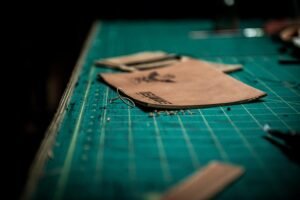Balancing Wildlife Preservation with Luxury: The Consequences for Alligator Leather
Welcome to the fascinating world of balancing wildlife preservation with luxury, particularly in the realm of alligator leather. As demand for exotic leather goods rises, the consequences of hunting alligators for their hides are becoming increasingly apparent. With more stringent regulations and advances in sustainable farming practices, the impact of wildlife conservation on the production of alligator leather is a topic of great importance. This article delves into the complex interplay between luxury fashion, environmental protection, and the ethics of using alligator hides in the industry. Have you ever wondered about the delicate balance between wildlife preservation and luxury goods made from exotic animal skins, like alligator leather? In this article, we will explore the consequences of the fashion industry’s demand for alligator leather on the conservation efforts of this iconic species. Let’s dive into the complex world of alligator leather production and its impact on alligator populations and ecosystems.

This image is property of images.pexels.com.
The allure of alligator leather
Alligator leather has long been prized for its unique texture, durability, and luxurious appearance. The fashion industry’s fascination with exotic skins, including alligator, has driven demand for products such as handbags, shoes, belts, and watch straps made from these high-end materials. The allure of alligator leather lies in its exclusivity and status symbol, making it a coveted choice among fashion enthusiasts and collectors.
What makes alligator leather so special?
Alligator leather is known for its distinctive scale pattern, which creates a visually striking and luxurious look. The leather’s durability and flexibility make it an ideal material for crafting high-end accessories that stand the test of time. The quality of alligator leather is often associated with luxury brands and designers who value craftsmanship and attention to detail in their products.
Alligator populations and conservation status
Alligators are large reptiles that are native to the southeastern United States, particularly in states like Florida, Louisiana, and Georgia. These apex predators play a crucial role in maintaining the balance of wetland ecosystems by controlling populations of various species and shaping the landscape through their feeding and nesting behaviors. However, due to habitat loss, hunting, and pollution, alligator populations have faced significant challenges over the years.
The conservation status of American alligators
American alligators were once on the brink of extinction due to overhunting and habitat destruction. In the early 20th century, alligator populations had declined dramatically, prompting conservation efforts to protect and recover the species. Thanks to successful conservation programs and legislation such as the Endangered Species Act, American alligators have made a remarkable recovery and are no longer classified as endangered. Today, alligator populations are considered stable and continue to thrive in their natural habitats.
Sustainable sourcing of alligator leather
To meet the demand for alligator leather while ensuring the conservation of wild populations, some companies have adopted sustainable sourcing practices. These practices involve responsibly harvesting alligators from the wild in accordance with strict regulations and quotas set by wildlife authorities. By working with licensed trappers and farms that adhere to ethical standards, luxury brands can minimize the impact of alligator leather production on wild populations and support conservation efforts.
The impact of the fashion industry on alligator populations
The booming demand for luxury goods made from alligator leather has raised concerns about the sustainability and ethics of sourcing materials from wild populations. The fashion industry’s influence on consumer trends and preferences has led to an increase in the production and sale of accessories made from exotic skins, including alligator. As a result, alligator populations face additional pressure from commercial hunting and poaching activities driven by the lucrative trade in exotic leather products.
Overexploitation and illegal trade
The high demand for alligator leather has created opportunities for illegal traders and poachers to exploit wild populations for profit. Alligator poaching and trafficking pose a serious threat to the survival of these animals and undermine conservation efforts aimed at protecting them. In some cases, illegal hunting practices such as using prohibited methods or exceeding quotas can result in the decline of alligator populations and disrupt their ecological role in wetland ecosystems.
Conservation challenges and conflicts
Balancing the interests of the fashion industry, conservationists, and policymakers presents a complex challenge in managing alligator populations sustainably. Conflicts may arise between stakeholders who prioritize economic benefits and those who advocate for wildlife preservation and ecosystem health. Conservation efforts must consider the needs of both alligators and local communities that depend on these species for their livelihoods, cultural heritage, and ecological services.
The ethics of luxury and exotic animal skins
The ethical implications of using exotic animal skins like alligator leather have sparked debates among consumers, fashion brands, and environmental advocates. The fashion industry’s reliance on exotic materials raises questions about the treatment of animals, the impact on ecosystems, and the sustainability of sourcing practices. Consumers are increasingly demanding transparency and accountability from brands regarding their ethical and environmental policies related to exotic leather production.
Animal welfare concerns
The welfare of alligators and other exotic animals raised for their skins is a central issue in the ethical debate surrounding luxury fashion. Practices such as confined breeding, overcrowding, and inhumane treatment of animals for the sake of profit can raise ethical red flags for consumers who value animal welfare. Brands that prioritize ethical sourcing and production methods are starting to gain traction with environmentally conscious consumers who seek alternatives to traditional luxury goods.
Environmental impact and habitat destruction
The demand for exotic animal skins has fueled habitat destruction, pollution, and biodiversity loss in regions where these species are native. The expansion of farming operations and hunting activities to meet market demand can lead to deforestation, water pollution, and disruption of natural ecosystems. The environmental consequences of sourcing alligator leather include the depletion of wetland habitats and the displacement of wildlife populations that rely on these ecosystems for survival.

This image is property of images.pexels.com.
Responsible consumption and sustainable alternatives
As awareness of the environmental and ethical issues associated with alligator leather production grows, consumers are increasingly seeking sustainable alternatives to traditional luxury goods. Responsible consumption practices, such as choosing products made from ethical and eco-friendly materials, can help reduce the demand for exotic animal skins and support the conservation of endangered species. By making informed choices and supporting brands that prioritize sustainability, consumers can drive positive change in the fashion industry.
Ethical fashion and transparency
Ethical fashion brands are leading the way in promoting transparency and accountability in the production of luxury goods. By adopting ethical sourcing practices, fair labor standards, and environmentally friendly manufacturing processes, these brands are setting new industry standards for responsible consumption. Consumers who value ethics and sustainability in fashion can make a difference by supporting brands that align with their values and contribute to positive social and environmental impact.
Sustainable materials and innovation
The development of sustainable materials and innovative technologies is revolutionizing the fashion industry and offering eco-friendly alternatives to traditional luxury goods. Brands are exploring new materials such as plant-based leathers, recycled fabrics, and bio-based polymers that mimic the look and feel of exotic animal skins without the environmental impact. By investing in sustainable materials and supporting innovative solutions, fashion brands can reduce their carbon footprint and promote a more sustainable future for the industry.
Conclusion
In conclusion, the production and consumption of alligator leather present complex challenges for wildlife conservation, ethics, and sustainability in the fashion industry. Balancing the demand for luxury goods made from exotic animal skins with the need to protect endangered species requires collaboration and innovation among stakeholders. By raising awareness, fostering responsible consumption practices, and supporting sustainable alternatives, we can work together to preserve alligator populations and promote a more ethical and environmentally conscious fashion industry. Remember, the choices you make as a consumer can make a difference in the future of alligator leather and the conservation of wildlife around the world.



